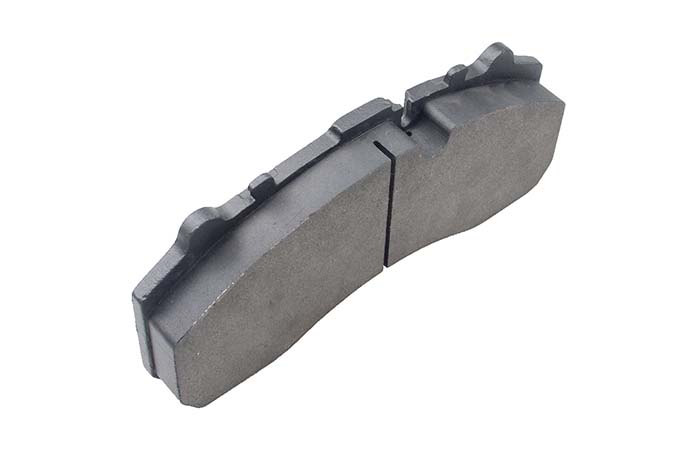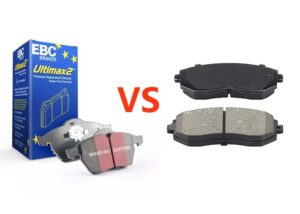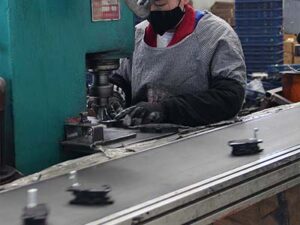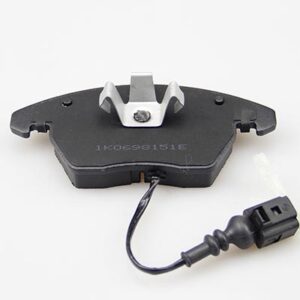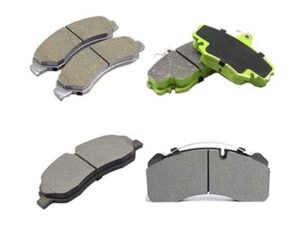Typically, our customers demand the following from brake pads:
- Braking performance.
- Good pedal feel.
- No noise (no long, sharp noise or other annoying noises), little to no dust.
- No vibration during braking.
- Long-lasting durability.
Types of brake pads
To meet these demands, KETULLA, as a professional brake pad factory, invests in research and development to formulate friction material compounds suitable for market needs, Types of brake pads:
The reason for adding ceramic fibers to the friction material mixture is that ceramic fibers are stable and significantly enhance the performance of the friction material. On the other hand, adding metal fibers to the friction material is for heat dissipation, especially when used in brake pads that can generate high temperatures.
The ceramic formulation provides a smoother pedal feel, whether the pads are at normal or high temperatures because the friction coefficient of ceramic brake pads decreases slower than that of semi-metallic. Additionally, ceramic formulations produce minimal noise and vibration, resulting in quieter braking with less damage to the brake discs. Ceramic pads hardly produce any dust, keeping the wheels clean and extending their lifespan. The craftsmanship of ceramic pads is superior, visibly appearing grayish-white, and nearly no dust is visible on the wheels.
Furthermore, the dust generated during braking with ceramic formula products is minimal, keeping the wheels clean and prolonging their lifespan. Despite having many advantages compared to other formulations, the ceramic formula is still not suitable for heavy-duty vehicles such as trucks used for towing or hauling, where semi-metallic pads would be more appropriate.
Semi-metallic formulations have a higher content of friction material fibers (reaching 45-50%), providing excellent heat dissipation performance. Compared to ceramic and low-metallic formulas, they can better handle high temperatures. Below 500°C, ceramic formula products wear less than semi-metallic. Above 500°C, the performance and wear of semi-metallic formula products are the best, but the likelihood of noise and brake squeal increases. Ketulla has addressed these issues by redeveloping semi-metallic brake pads to avoid the possibility of squealing at high temperatures. This is achieved by incorporating advanced materials such as graphene into the mixture and using a balanced ratio, which has been widely accepted by more purchasers.
The disadvantages and advantages of ceramic and semi-metallic brake pads
Advantages of KETULLA Ceramic Brake Pads:
- Minimal thermal fade: During continuous braking, even when brake temperatures instantly rise above 500 degrees Celsius, they do not melt and still maintain excellent braking performance.
- High braking force, resulting in shorter braking distances.
- Low probability of noise generation.
- Excellent braking performance in wet conditions and on slippery roads, without squealing.
- Prolongs the lifespan of brake discs: Ceramic brake pads, as they do not contain metal fibers, do not cause scratches on brake discs, making them more friendly to brake discs.
Disadvantages:
- Higher price: Ceramic brake pads are priced 30% higher than semi-metallic brake pads.
- Soft braking feel: This is not necessarily a disadvantage, but rather a characteristic of ceramic brake pads.
Advantages & disadvantages of Semi-Metallic Brake Pads:
- Lower price: They are priced 30% lower than ceramic brake pads.
- Excellent thermal stability: Highly stable below the friction coefficient. They exhibit no thermal degradation and have good thermal stability. With high power absorption per unit area and a high thermal conductivity coefficient, they are suitable for braking conditions during high-speed heavy-duty driving, commonly used in ordinary cars.
- Low noise: Common brake pad noise, often referred to as caliper noise, is caused by caliper assembly vibration or suspension system vibration. New cars may have slight vibrations in the caliper or suspension system, especially in the early morning, such as winter mornings, and should be inspected for calipers, suspension, and liners.
- Good thermal conductivity: Minimal temperature gradient, especially suitable for small disc brake products. During braking, the brake pads overcome friction work, increasing the internal energy of the brake pads and raising their temperature. The braking process converts mechanical energy into heat energy, which is dissipated through friction.
- Excellent wear resistance: The lifespan is 3-5 times that of asbestos friction materials. Semi-metallic brake pads have over 25% higher wear resistance than asbestos brake pads, with advantages such as high friction coefficient, good thermal conductivity, and ease of processing and shaping.
- Relatively stable friction coefficient: They exhibit good friction performance under high loads, with a stable friction coefficient. The friction coefficient is the most important performance indicator for any friction material and is related to the braking capability of brake pads. During braking, friction generates heat, increasing the working temperature. Generally, the friction material of brake pads is affected by temperature, and the friction coefficient begins to decrease. In practical use, friction force decreases, thereby reducing braking effectiveness. However, Ketulla effectively avoids this situation through research, analysis, and reasonable adjustment of formulations.
What type of brake pads are best for trucks?
When purchasing truck brake pads, it’s crucial to consider the coefficient of friction, as it determines the basic braking torque of the brake pads. If it’s too high, it can cause wheel lock-up and loss of control during braking, while if it’s too low, it can result in excessively long braking distances, posing a danger.
Temperature-wise, truck brake pads generate instantaneous high temperatures during braking, especially during high-speed driving or emergency braking. In high-temperature conditions, the friction coefficient of the brake pads decreases.
KETULLA has introduced a new type of semi-metallic brake pads, designated as type B, into the market after upgrading the formulation and conducting research. The friction coefficient ranges from 0.38 to 0.45, providing a balanced braking feel between ceramic and semi-metallic brake pads. Unlike ceramic brake pads, which may feel soft during braking, these pads incorporate fiber threads and graphene materials, offering:
- Fast heat dissipation: Preventing the brake performance from failing under high temperatures during continuous braking when the truck is heavily loaded.
- Ceramic fibers: Adding ceramic fibers reduces the wear on the brake discs, extending their lifespan.
- Shorter braking distances, avoiding the occurrence of dangerous situations due to excessively long braking distances.
In conclusion, in the selection of truck brake pad materials, we recommend using semi-metallic brake pads with type B material to ensure that our trucks have no concerns regarding braking, thereby enhancing the safety of new vehicles.
